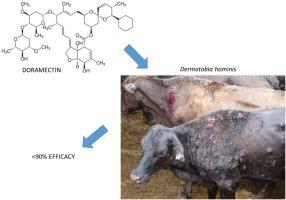Veterinary Parasitology ( IF 2.0 ) Pub Date : 2020-12-11 , DOI: 10.1016/j.vetpar.2020.109335 Mário Henrique Conde , Dyego Gonçalves Lino Borges , Mariana Green de Freitas , Marcos Cabrera da Silva , Fernando de Almeida Borges

|
The objective of this study was to evaluate the therapeutic efficacy of 1 % injectable doramectin to control Dermatobia hominis in naturally infested beef cattle in a farm with history of clinical parasitism after avermectin use. The study was conducted in a commercial beef cattle farm in Brazil. Twenty crossbred cattle (Nellore x Angus) were selected based on the minimum number of 10 live larvae. Assessment of infestation was performed based on tactile-visual inspection of the entire body of the animals. The animals were allocated to two experimental groups of ten animals each: treated group - dosed with doramectin 200 μg/kg live weight (LW), and control group - dosed with saline solution 1 mL/50 kg LW. Both treatments were administered subcutaneously in a single dose. After treatment, larval counts were performed at 1, 3, 7 and 14 days post-treatment (DPT). For the treatment to be considered efficient, it should reach an efficacy greater than or equal to 90 % by the 10th DPT and the average larval count in the treated animals should be statistically lower than the average larval count in the control group. The geometric means of larval counts at the beginning of the study were 27.2 and 26.3 for the control and treated groups, respectively. After 72 h of treatment, there was a significant reduction (p < 0.01) in the larvae counts of the treated group, extending to the 14th DPT, at which point maximum efficacy for doramectin (86.3 %) was obtained. After treatment, 90 % of the animals remained parasitized with live larvae on the 7th DPT and 70 % on the 14th DPT, while in the control group, all animals were infested on all dates. The administration of injectable doramectin was not effective in controlling D. hominis in naturally infested cattle.
中文翻译:

牛对多拉菌素有抗性的人皮癣的首次报道
这项研究的目的是评估1%注射的多拉菌素对控制人皮性皮肤病的疗效。在使用阿维菌素后有临床寄生虫病史的农场中,自然感染了肉牛。该研究是在巴西的一家商业肉牛场进行的。根据最少10个活幼虫的数量选择了20头杂交牛(Nellore x Angus)。基于对动物整个身体的触觉-视觉检查来进行侵染评估。将动物分为两个实验组,每组十只动物:治疗组-给予多拉菌素200μg/ kg活重(LW),对照组-给予盐溶液1 mL / 50 kg LW。两种治疗均以单剂量皮下给药。治疗后,在治疗后1、3、7和14天(DPT)进行幼虫计数。为了使治疗有效,到第10次DPT时,其功效应大于或等于90%,并且治疗动物的平均幼虫计数应统计学低于对照组的平均幼虫计数。在研究开始时,对照组和治疗组幼虫计数的几何平均值分别为27.2和26.3。治疗72小时后,治疗组的幼虫数量显着减少(p <0.01),一直持续到第14天DPT,此时获得了对多拉菌素的最大疗效(86.3%)。治疗后,在第7个DPT上有90%的动物被活幼虫寄生,在第14个DPT上有70%的动物被寄生,而在对照组中,所有动物在所有日期都被感染。注射多拉菌素对控制病情无效 在研究开始时,对照组和治疗组幼虫计数的几何平均值分别为27.2和26.3。治疗72小时后,治疗组的幼虫数量显着减少(p <0.01),一直持续到第14天DPT,此时获得了对多拉菌素的最大疗效(86.3%)。治疗后,在第7个DPT上有90%的动物被活幼虫寄生,在第14个DPT上有70%的动物被寄生,而在对照组中,所有动物在所有日期都被感染。注射多拉菌素对控制病情无效 在研究开始时,对照组和治疗组幼虫计数的几何平均值分别为27.2和26.3。治疗72小时后,治疗组的幼虫数量显着减少(p <0.01),一直持续到第14天DPT,此时获得了对多拉菌素的最大疗效(86.3%)。治疗后,在第7个DPT上有90%的动物被活幼虫寄生,在第14个DPT上有70%的动物被寄生,而在对照组中,所有动物在所有日期都被感染。注射多拉菌素对控制病情无效 扩展到第14个DPT,此时获得了多拉菌素的最大功效(86.3%)。治疗后,在第7个DPT上有90%的动物被活幼虫寄生,在第14个DPT上有70%的动物被寄生,而在对照组中,所有动物在所有日期都被感染。注射多拉菌素对控制病情无效 扩展到第14个DPT,此时获得了多拉菌素的最大功效(86.3%)。治疗后,在第7个DPT上有90%的动物被活幼虫寄生,在第14个DPT上有70%的动物被寄生,而在对照组中,所有动物在所有日期都被感染。注射多拉菌素对控制病情无效自然感染牛的D.hominis。











































 京公网安备 11010802027423号
京公网安备 11010802027423号